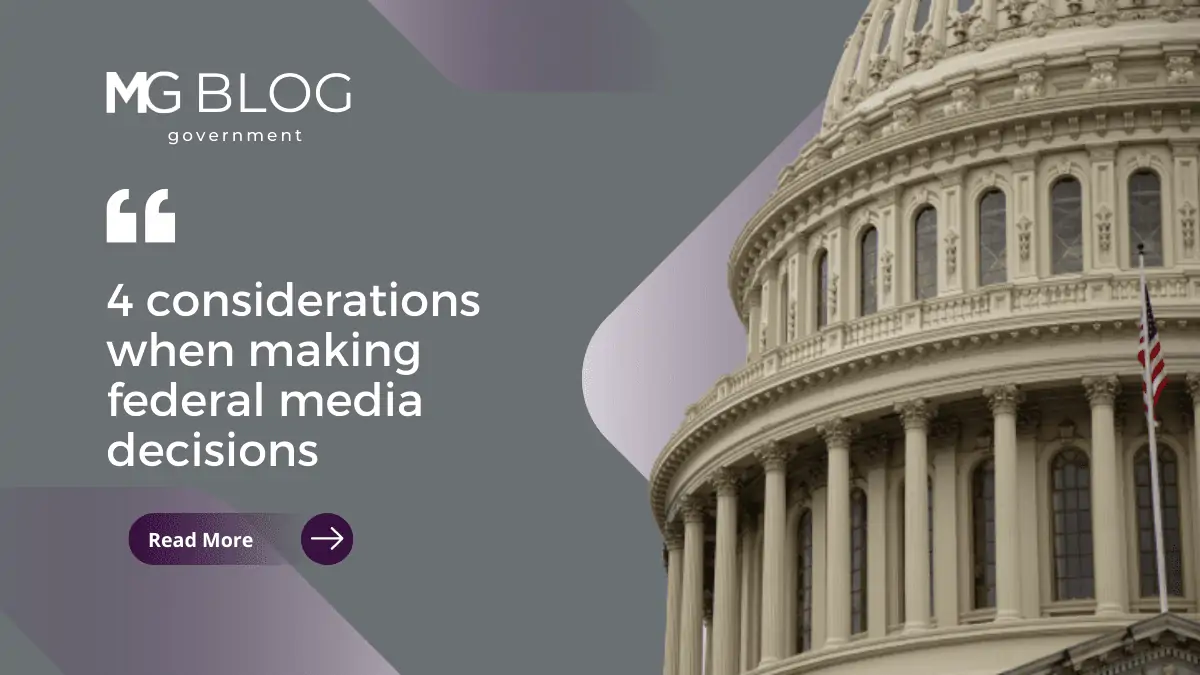2021 was an unprecedented year in the government media landscape, and we’re forecasting the shifting momentum will continue in 2022. It’s only fair for a media landscape to match a rapidly changing environment in the federal government.
We’ve seen continued restrictions due to COVID-19 affect how federal employees work and operate, and therefore change how they access, digest, and trust information emanating from the media. How can we as marketers “win” at making effective and informed media-related decisions in a constantly changing federal space?
To start, let’s look at information from Market Connections’ 2021 Federal Media & Marketing Survey. Published annually, the survey identifies who in the government is consuming media, what media they’re digesting, and through which mediums they’re digesting it. This year, Market Connections collected data from approximately 2,700 federal employees, over 200 media outlets, and over 20 social media websites.
Here is the evidence the survey discovered.
Who is the target audience?
To solve the mystery of who the federal audience is, it is important to evaluate the many demographic facets involved. Split relatively equally between civilian, independent, defense, and military agency employees, the federal workforce is composed of a diverse group of professionals, with a multitude of goals. It is also essential to remember that, while the majority of federal employees are local to the capital region, the rise of remote work is increasing the number of workers outside the Beltway. Additionally, age ranges do vary within the federal landscape, but the majority target audience falls within the 55+ age range, affecting the decision of which mediums to pursue.
Where are they located?
Remote work has certainly not gone away, but is it here to stay for the long run? The short answer is yes – in some form.
Currently, 69% of respondents work remotely either full or part-time, and 67% expect to continue to be remote at least part-time going forward.
For the one-third working entirely in-office and commuting five days a week, the vast majority drive alone. Only 10% of respondents utilize public transportation or carpool.
Mentally, employee morale is the biggest concern among respondents, followed by changes in government policies and the retirement of current employees. There is also an eminent lack of trust intensifying across different parties. Government contractors ranked least trusted at 28% of respondents and professional associations ranked the highest at 54%.
Due to the Great Resignation, more than half of federal agencies report needing to increase staff in the next twelve months and, of those hiring, entry-level positions account for the highest need by a large majority.
How are they finding their information?
More often than not, federal employees are seeking information that aligns with their personal interests in addition to breaking, industry-wide news. Although they’re not typical channels for breaking and local news, federal employees prefer to get their federal-specific news from digital sites, most often visiting Federal News Network, Politico, Federal Times, and GovExec.
Social media usage remained steady among the federal audience. Facebook and LinkedIn took the top spots, with a variety of interactions on Instagram, Twitter, TikTok, and Snapchat as well. In addition to following federal agencies on social media, federal employees — most notably GS-13 and above — also engage with many trade associations as well.
But all this extra attention on digital and social media had to be pulled from somewhere, and podcasts and events suffered the casualties. In fact, only 44% of survey respondents listened to podcasts this year, down from 2020, and only 27% of those podcasts were work-related.
In-person events unsurprisingly experienced an all-time low attendance in 2021, but webinars continue as a promising alternative to the conferences of the past.
Why is this important to us as marketers?
While we all find comfort in a routine, COVID continues to disrupt the ways teams communicate and how media is consumed. The uncertain environment continues to isolate many, no matter if they are teleworking or in-office.
Due to this isolation affecting employee morale, individuals are cautiously looking out for their own concerns and issues first and trusting the media less.
Messaging should clearly meet needs, be unbiased or not blatantly tied to an organization, and be disseminated only to the target audience to prevent burnout.
Now more than ever, it is important to understand your audience for a B2G campaign and stay nimble. Federal workers are looking for new opportunities, evaluating retirement, and seeking human interaction in some form. Marketers have to look at non-traditional ways, such as social media, to reach their target audience in new, engaging ways.
B2G marketers no longer need to guess where the federal audience is reading their news; we have evidence and data on the who, where, how, and why.
If you’re puzzled about your government-focused media strategy, let Merritt Group help put the pieces together. Reach out to us.




